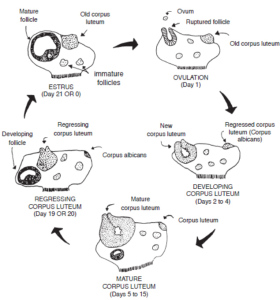Estrous cycle
This cyclic process is called the estrous cycle and consists of a definite sequence of events, both physiological and behavioral. The estrous cycle of the cow starts after puberty and occurs approximately every 21 days (17 to 24 days) except for pregnancy, reproductive disease or hormonal disorder. During estrous cycle, the reproductive tract is prepared for estrus or heat (the period of sexual receptivity) and ovulation (ovum release). The cycle is divided into four parts: proestrus, estrus, metestrus and diestrus.
Definition :
Proestrus is the period between the regression of the corpus luteum of the previous cycle and estrus. The period proestrus translated the follicular development. Figures 2 and 3 outline the sequence of anatomical and hormonal changes that occur during a typical 21-day cycle in which pregnancy does not occur. Estrus is the period when high amount of estrogen is presents in the blood. The estrogen produces the behavioral signs of estrus, such as the mounting of other cows, the willingness to stand while mounted by other cow, and general increase of activity. Estrus is followed by a 3 to 4 day period referred to as metestrus. During this period the corpus luteum develops under the influence of LH and starts to produce increasing amounts of progesterone. The period between metestrus and the beginning of the regression of the corpus luteum is referred to as diestrus. | Figure 2 : The ovarian changes during a normal estrous cycle (21 days) without pregnancy. The development and regression of the Corpus Luteum are continuous process. |  Information[1] Information[1] |
Description
Day 0: The cow is in estrus (standing heat) due to an increased concentration of estrogen for 18 hours (range 12 to 24 hours). As estrogen levels reach a certain threshold level, a surge of LH is released by the pituitary. About 12 hours after the end of standing heat, the mature Graafian follicle ovulates (ruptures) in response to LH released.
Days 1–2: The cells that formerly lined the follicle change and become the luteal cells of the corpus luteum. This change in cell form is caused by hormonal action, primarily the action of LH.
Days 2–5 The corpus luteum grows rap¬idly in both size and function. At this stage, numerous follicles may be seen on the ovary, but by day 5 they have begun to regress.
Days 5–16: The corpus luteum continues to develop and typically reaches its maximum growth and function by day 15 or 16. It secretes the hormone progesterone, which inhibits LH release by the pituitary gland. During this period, the ovaries are relatively inactive except for the functional corpus luteum. No follicles reach maturity and/or ovulate because of high concentrations of progesterone.
Days 16–18: Increased follicular growth and accompanying estrogen secretion by the ovary stimulate PGF2α secretion by the uterus, causing rapid regression of the corpus luteum.
Days 18–19: The corpus luteum is almost nonfunctional and progesterone release is suppressed, removing the blocking action of progesterone on LH and FSH. Of the several fol¬licles that are initially recruited, one becomes dominant by a surge in rapid growth and activity. As this Graafian fol¬licle grows, it secretes increasing amounts of estrogen, and the smaller follicles regress.
Days 19–20: With the increase in estrogen release by the Graafian follicle and a corresponding decrease in proges¬terone by the regressing corpus luteum, estrus or heat will occur (cycle has now returned to day 0). The high estrogen concentration in the blood triggers a release of LH near the onset of heat. Following this surge in LH blood concentrations, the mature follicle ruptures to release the ovum, and the cellular tissue left behind becomes luteinized and forms a new corpus luteum (cycle has now returned to days 1–2). Progesterone again becomes the dominant hormone.
The sequence of events that occur during the estrous cycle showed above is based on a full cycle in which pregnancy does not occur. If the ovum is fertilized and begins developing in the uterus, the corpus luteum does not regress but continues to function and secrete progesterone. During pregnancy, no follicles develop to maturity and heat does not normally occur. Increased concen-trations of progesterone promote uterine dormancy, provid¬ing the most favorable conditions for the developing fetus.
Any condition that prolongs the period of time when blood concentrations of progesterone remain high (such as implanting, injecting, or feeding progestins for estrus synchronization) will keep the female from exhibiting estrus. Occasionally, the corpus luteum does not regress normally even though the animal does not become pregnant (pseudo-pregnancy).
Occasionally, abnormally short estrous cycles (7–11 days) occur. This condition appears to occur because either no corpus luteum is formed or, if one is formed, it is non-functional and progesterone concentration remains too low to sufficiently suppress the release of gonadotropins (FSH and/or LH) from the anterior pituitary.
Cows also have periods of anestrus (noncycling). For example, an anestrous period is commonly observed in cows following calving. Low levels of nutrition can contribute to the duration of anestrus, especially in young cows nursing calves.
Estrus is not always accompanied by ovulation. Heat without ovulation (anovulatory heat) will not result in pregnancy, even if the female is bred. Ovulation without the external signs of heat (quiet or silent heats) is not uncommon in cows, especially the first few weeks after calving. Such females will generally not “stand” to be bred by a bull.






